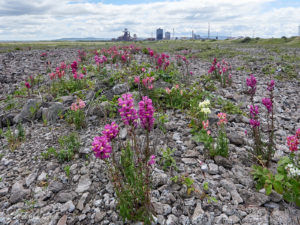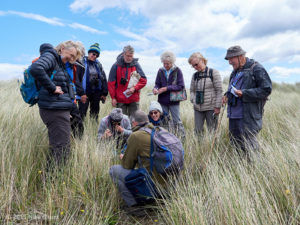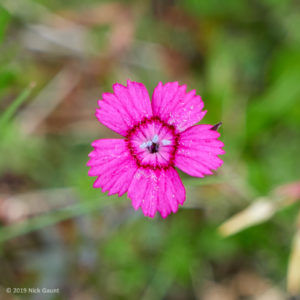Leader: Dave Barlow, County Recorder for VC 62, NE Yorkshire
South Gare is an area of reclaimed land and breakwater on the south side of the River Tees near Redcar. The extensive area is made from vast quantities of basic slag generated over a hundred years ago from the blast furnaces used in steelmaking. Production methods in those times were inefficient so considerable elements of the original limestone remain, producing a base rich soil. The eastern dunes are protected by three slag banks close to the breakwater so are currently not flooded by the sea. In addition, there has been recent dumping of quantities of soil from an unknown source in two very large mounds.
Dave has known the site for many years and has a fantastic knowledge of the location of its treasures despite the vastness of the area. He was a very authoritative guide with numerous anecdotes and an excellent companion for our field trip. There were so many exciting species that this account omits many and the species list should be consulted for the true variety of what was present (what we normally regard as ‘common’ species, were actually quite uncommon in this unusual location).
As usual, recording commenced as we got out of the cars with musk thistle (Carduus nutans) numerous on the roadside. The normal place of common meadow grasses was replaced by sculptural rosettes of buckshorn plantain (Plantago coronopus) and sea plantain (Plantago maritima). Innumerable drifts of hop trefoil (Trifolium campestre), common stork’s-bill (Erodium cicutarium) and restharrow (Ononis repens) were interspersed with sea fern grass (Catapodium maritinum), hoary mustard (Hirschfeldia incana), mignonette (Reseda lutea) and sea rocket (Cakile maritima). Small pockets of blue fleabane (Erigeron acer), prickly lettuce (Lactuca serriola), eastern rocket (Sisymbrium orientale) and purple milk-vetch (Astragalus danicus) added further interest.
Proceeding onto the main area revealed the sturdy alexanders (Smyrnium olusatrum) contrasting with the delicate sea pearlwort (Sagina maritima) and the surprising Duke of Argyle’s tea plant (Lycium barbarum). The clovers, strawberry (Trifolium frangiferum), hare’s foot (Trifolium arvense) and zigzag (Trifolium medium) each added their own ‘jizz’ to the absorbing botanical patchwork. The grasses were represented by maritime versions of inland species including the tiny sand couch (Elymus farctus). Other treasures included frosted orache (Atriplex laciniate), sand cat’s tail (Phleum arenarium), sea holly (Eryngium maritimum), lesser meadow rue (Thalictrum minus), crow garlic (Allium vineale), ploughman’s spikenard (Inula conzyae), bloody crane’s bill (Geranium sanguineum), viper’s bugloss in jaw-dropping thousands (Echium vulgare), carline thistle (Carlina vulgaris) and the Uig hawkweed (Hieracium uiginskyense). Dave enthusiastically explained some principles of the identification of the notorious apomictic hawkweeds which will stimulate our future field trips and could be a lifetime’s study in themselves.
One particular highlight, demanding expressions of emotion not normally witnessed in well-behaved botanists, was the maiden pink (Dianthus deltoides), vivid against the background greens and yellows. Large numbers of orchids (pyramidal (Anacamptis pyramidalis), northern marsh (Dactyloriza purpurella), common spotted (Dactylorhyza fuchsii), bee (Ophrys apifera) and marsh fragrant (Gymnadenia densiflora)) were also present.
A large pond and damper area provided slender spike rush (Eleocharis uniglumis), green ribbed sedge (Carex binerva), frog (Juncus ranarius) and toad rush (Juncus bufonius), hemlock (Conium maculatum) and common (Schoenoplectus lacustris), sea (Bolboschoenus maritimus)and grey clubrush (Schoenoplectus tabernaemontani).
Other highlights included parsley water dropwort (Oenanthe lachenalii), lesser centuary (Centaurium pulchellum) and hare’s tail grass (Lagurus ovatus), not to mention narrow leaved ragwort (Senecio inaequidens) and sea wormwood (Artimesia maritima).
Some plants were totally out of context, particularly naturalised garden escapees in a slag moonscape with rampant bushy snapdragons (Antirrhinum majus) growing apparently without soil in vivid colours against a backdrop of abandoned steel manufacturing plant, sweet william (Dianthus barbatus) nestling amongst discarded limestone boulders and orange bladder senna (Colutea arborescens) scrub.
Many thanks to Dave for leading, and Kerry for organising this outstanding occasion.
Hazel Mitford




